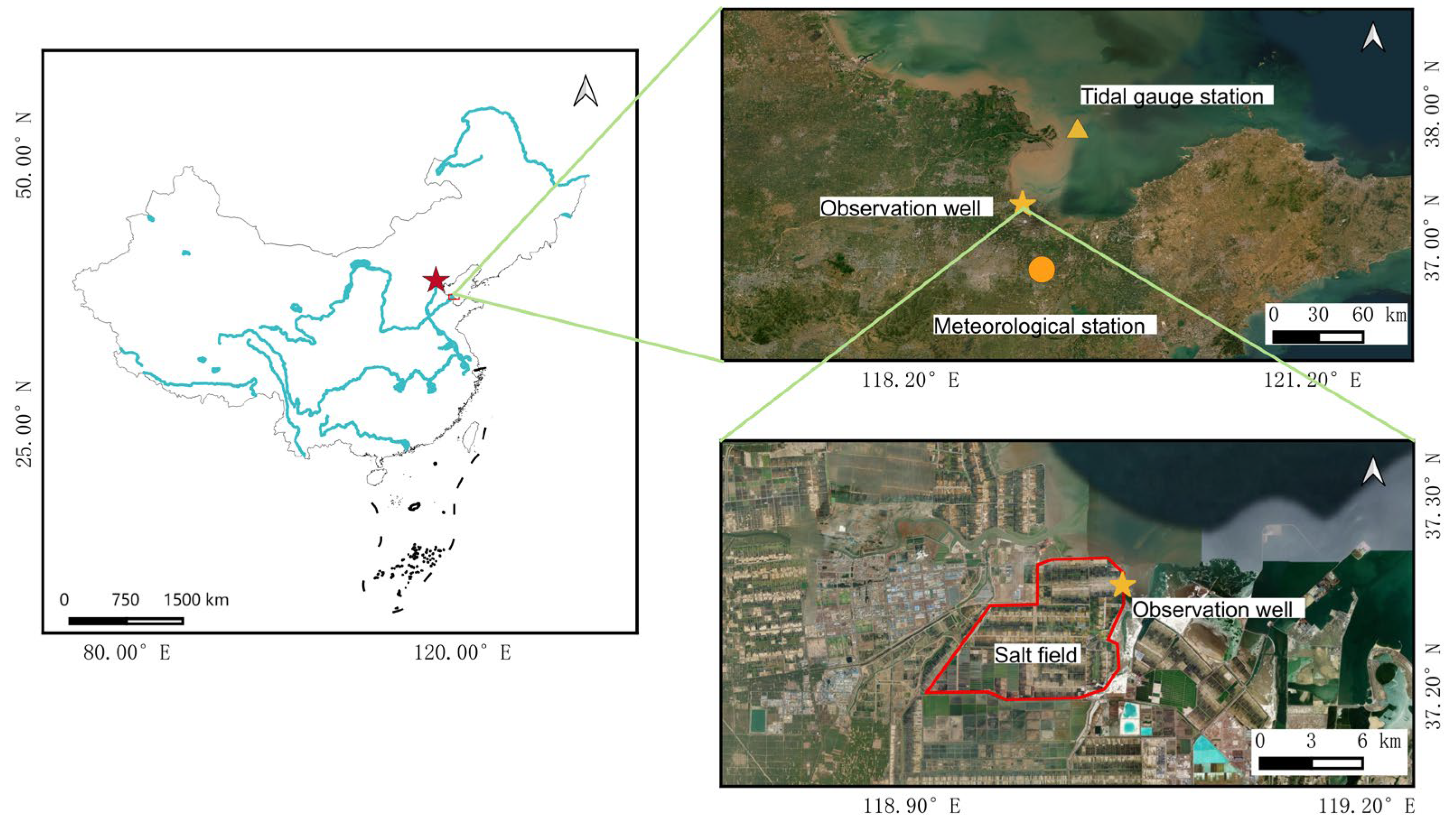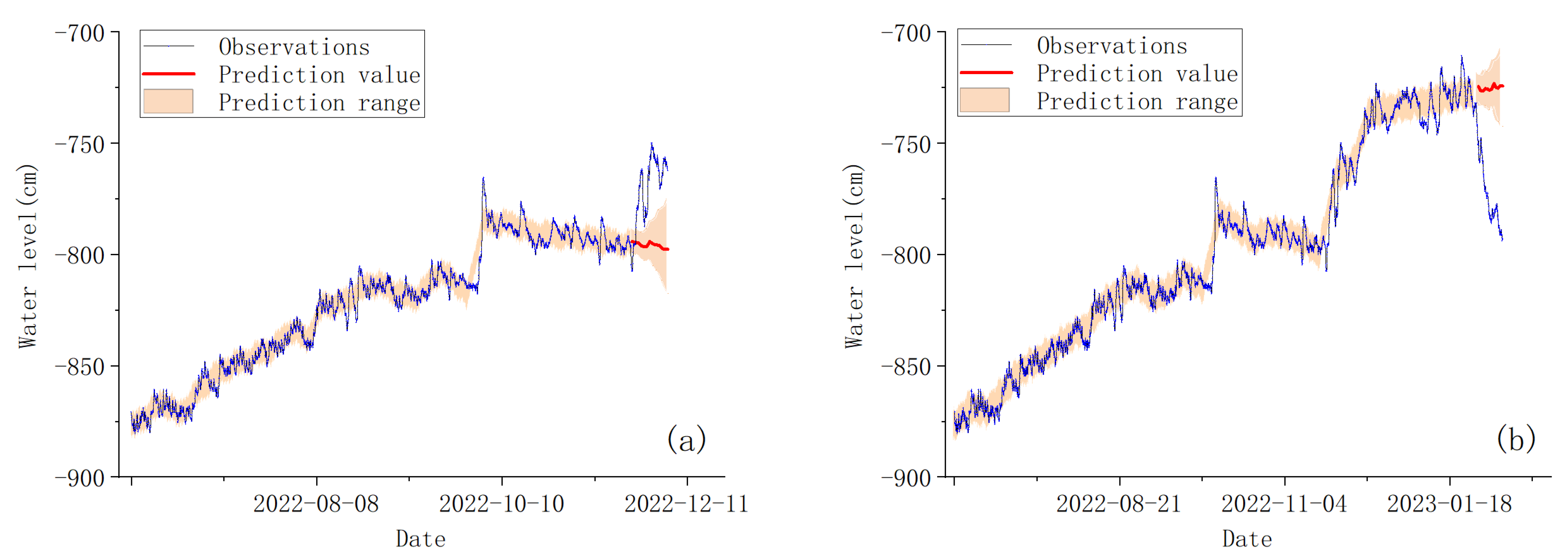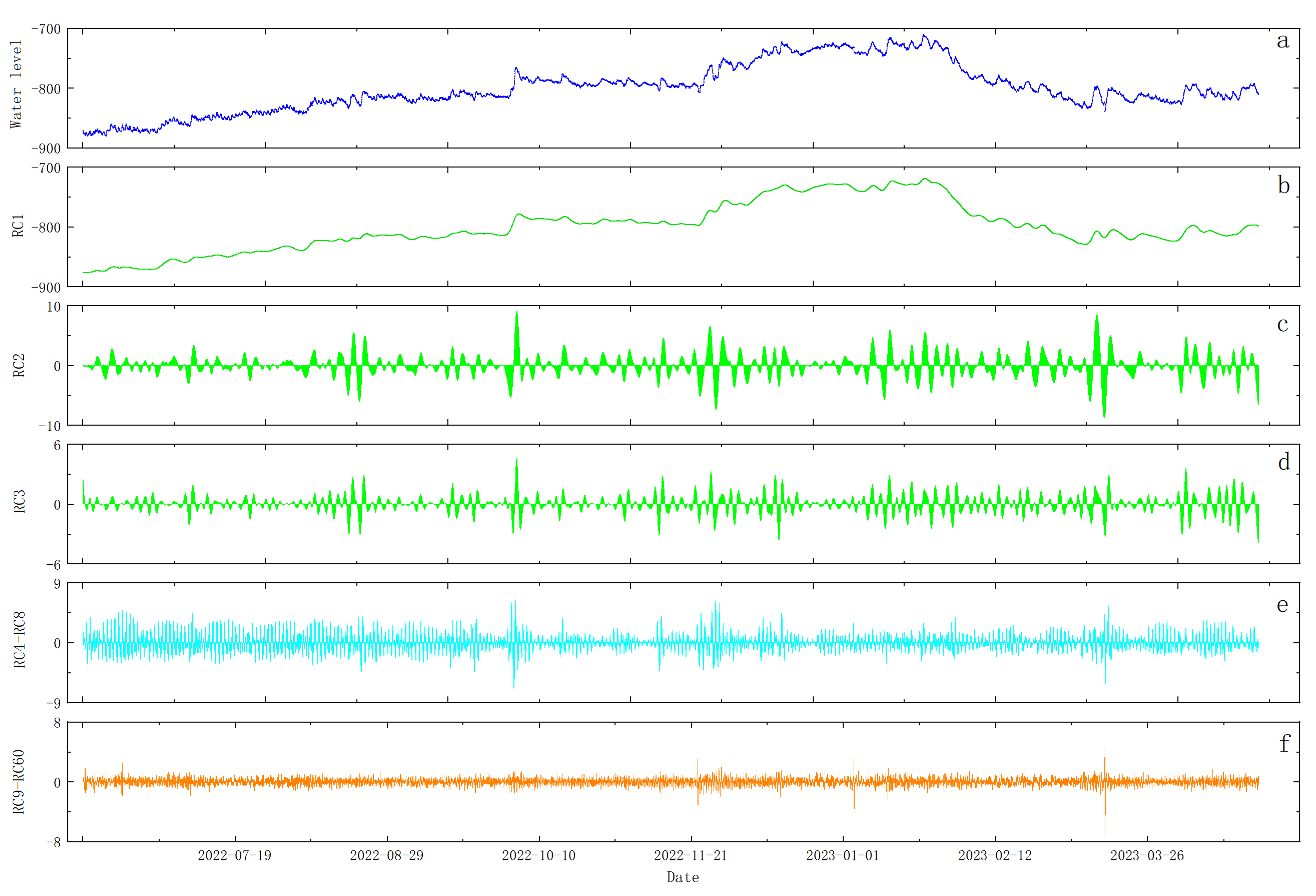Study on the Variation in Coastal Groundwater Levels under High-Intensity Brine Extraction Conditions
Abstract
:1. Introduction
2. Materials and Methods
2.1. The Study Area
2.2. Data Collection
2.3. Methodology
3. Results
3.1. Characteristics of Time Series Variations
3.2. Frequency of Observation Data
3.3. Wavelet Coherence
3.4. Singular Spectral Decomposition
3.5. Forecasting
4. Discussion
5. Conclusions
Author Contributions
Funding
Institutional Review Board Statement
Informed Consent Statement
Data Availability Statement
Acknowledgments
Conflicts of Interest
References
- Razzaq, A.; Liu, H.; Xiao, M.; Mehmood, K.; Shahzad, M.A.; Zhou, Y. Analyzing past and future trends in Pakistan’s groundwater irrigation development: Implications for environmental sustainability and food security. Envrion. Sci. Pollut. Res. 2023, 30, 35413–35429. [Google Scholar] [CrossRef]
- Abbas, A.; Waseem, M.; Ullah, W.; Zhao, C.; Zhu, J. Spatiotemporal Analysis of Meteorological and Hydrological Droughts and Their Propagations. Water 2021, 13, 2237. [Google Scholar] [CrossRef]
- Zou, J.; Xie, Z.; Yu, Y.; Zhan, C.; Sun, Q. Climatic responses to anthropogenic groundwater exploitation: A case study of the Haihe River Basin, Northern China. Clim. Dyn. 2014, 42, 2125–2145. [Google Scholar] [CrossRef]
- Alfarrah, N.; Walraevens, K. Groundwater Overexploitation and Seawater Intrusion in Coastal Areas of Arid and Semi-Arid Regions. Water 2018, 10, 143. [Google Scholar] [CrossRef]
- Ma, J.; Zhou, Z.; Guo, Q.; Zhu, S.; Dai, Y.; Shen, Q. Spatial Characterization of Seawater Intrusion in a Coastal Aquifer of Northeast Liaodong Bay, China. Sustainability 2019, 11, 7013. [Google Scholar] [CrossRef]
- Cao, T.; Han, D.; Song, X. Past, present, and future of global seawater intrusion research: A bibliometric analysis. J. Hydrol. 2021, 603, 126844. [Google Scholar] [CrossRef]
- Samani, S.; Moghaddam, A.A. Hydrogeochemical characteristics and origin of salinity in Ajabshir aquifer, East Azerbaijan, Iran. Q. J. Eng. Geol. Hydrogeol. 2015, 48, 175–189. [Google Scholar] [CrossRef]
- Zhang, X.; Dong, F.; Chen, G.; Dai, Z. Advance prediction of coastal groundwater levels with temporal convolutional and long short-term memory networks. Hydrol. Earth Syst. Sci. 2023, 27, 83–96. [Google Scholar] [CrossRef]
- Singaraja, C.; Chidambaram, S.; Jacob, N. A study on the influence of tides on the water table conditions of the shallow coastal aquifers. Appl. Water Sci. 2018, 8, 11. [Google Scholar] [CrossRef]
- Li, H.; Jiao, J.J. Review of Analytical Studies of Tidal Groundwater Flow in Coastal Aquifer Systems. In Proceedings of the International Symposium on Water Resources and the Urban Environment, Wuhan, China, 9–10 November 2003. [Google Scholar]
- Tularam, G.A.; Keeler, H.P. The study of coastal groundwater depth and salinity variation using time-series analysis. Environ. Impact Assess. 2006, 26, 633–642. [Google Scholar] [CrossRef]
- Dong, L.; Chen, J.; Fu, C.; Jiang, H. Analysis of groundwater-level fluctuation in a coastal confined aquifer induced by sea-level variation. Hydrogeol. J. 2012, 20, 719–726. [Google Scholar] [CrossRef]
- Hussain, F.; Wu, R.; Shih, D. Water table response to rainfall and groundwater simulation using physics-based numerical model: WASH123D. J. Hydrol. Reg. Stud. 2022, 39, 100988. [Google Scholar] [CrossRef]
- Hoover, D.J.; Odigie, K.O.; Swarzenski, P.W.; Barnard, P. Sea-level rise and coastal groundwater inundation and shoaling at select sites in California, USA. J. Hydrol. Reg. Stud. 2017, 11, 234–249. [Google Scholar] [CrossRef]
- Yang, F.; Jia, C.; Chang, W.; Yang, H.; Wang, C.; Fan, Q. Integrating hydrochemical and microbial methods to identify hydraulic connections between three saltworks in southern Laizhou Bay, China. Hydrogeol. J. 2022, 30, 1847–1862. [Google Scholar] [CrossRef]
- McLin, S. Spectral analysis of observed aquifer water level fluctuations. Comput. Geosci. 2012, 46, 264–271. [Google Scholar] [CrossRef]
- Han, D.; Kohfahl, C.; Song, X.; Xiao, G.; Yang, J. Geochemical and isotopic evidence for palaeo-seawater intrusion into the south coast aquifer of Laizhou Bay, China. Appl. Geochem. 2011, 26, 863–883. [Google Scholar] [CrossRef]
- Liu, S.; Tang, Z.; Gao, M.; Hou, G. Evolutionary process of saline-water intrusion in Holocene and Late Pleistocene groundwater in southern Laizhou Bay. Sci. Total Environ. 2017, 607, 586–599. [Google Scholar] [CrossRef]
- Han, Y.; Meng, G.; Wang, S. A preliminary study on the distribution and genesis of underground brine in the littoral plain of Laizhou Bay in the Bohai Sea. Chin. J. Oceanol. Limnol. 1993, 11, 46–56. [Google Scholar]
- Han, D.M.; Song, X.F.; Currell, M.J.; Yang, J.L.; Xiao, G.Q. Chemical and isotopic constraints on evolution of groundwater salinization in the coastal plain aquifer of Laizhou Bay, China. J. Hydrol. 2014, 508, 12–27. [Google Scholar] [CrossRef]
- He, L.; Xue, C.; Ye, S.; Laws, E.A.; Yuan, H.; Yang, S.; Du, X. Holocene evolution of the Liaohe Delta, a tide-dominated delta formed by multiple rivers in Northeast China. J. Asian Earth Sci. 2018, 152, 52–68. [Google Scholar] [CrossRef]
- Vann, S.; Puttiwongrak, A.; Suteerasak, T.; Koedsin, W. Delineation of Seawater Intrusion Using Geo-Electrical Survey in a Coastal Aquifer of Kamala Beach, Phuket, Thailand. Water 2020, 12, 506. [Google Scholar] [CrossRef]
- Smith, A.; Lott, N.; Vose, R. The Integrated Surface Database: Recent Developments and Partnerships. Bull. Am. Meteorol. Soc. 2011, 92, 704–708. [Google Scholar] [CrossRef]
- NAMIAS, V. The Fractional Order Fourier Transform and its Application to Quantum Mechanics. IMA J. Appl. Math. 1980, 25, 241–265. [Google Scholar] [CrossRef]
- Kendall, A.D.; Hyndman, D.W.; Hyndman, D.W.; Day Lewis, F.D.; Hyndman, D.W.; Singha, K.; Day-Lewis, F.D.; Singha, K. Examining watershed processes using spectral analysis methods including the scaled-windowed Fourier transform. Geophys. Monogr. 2007, 171, 183–200. [Google Scholar]
- Acworth, R.I.; Rau, G.C.; McCallum, A.M.; Andersen, M.S.; Cuthbert, M.O. Understanding connected surface-water/groundwater systems using Fourier analysis of daily and sub-daily head fluctuations. Hydrogeol. J. 2015, 23, 143–159. [Google Scholar] [CrossRef]
- Fleming, S.W.; Marsh Lavenue, A.; Aly, A.H.; Adams, A. Practical applications of spectral analysis to hydrologic time series. Hydrol. Process. 2002, 16, 565–574. [Google Scholar] [CrossRef]
- Moosavi, V.; Vafakhah, M.; Shirmohammadi, B.; Behnia, N. A Wavelet-ANFIS Hybrid Model for Groundwater Level Forecasting for Different Prediction Periods. Water Resour. Manag. 2013, 27, 1301–1321. [Google Scholar] [CrossRef]
- Muchebve, E.; Nakamura, Y.; Suzuki, T.; Kamiya, H. Analysis of the dynamic characteristics of seawater intrusion using partial wavelet coherence: A case study at Nakaura Watergate, Japan. Stoch. Environ. Res. Risk Assess. 2016, 30, 2143–2154. [Google Scholar] [CrossRef]
- Biswas, A.; Si, B.C. Identifying scale specific controls of soil water storage in a hummocky landscape using wavelet coherency. Geoderma 2011, 165, 50–59. [Google Scholar] [CrossRef]
- Li, M.; Hinnov, L.; Kump, L. Acycle: Time-series analysis software for paleoclimate research and education. Comput. Geosci. 2019, 127, 12–22. [Google Scholar] [CrossRef]
- Torrence, C.; Compo, G.P. A Practical Guide to Wavelet Analysis. Bull. Am. Meteorol. Soc. 1998, 79, 61–78. [Google Scholar] [CrossRef]
- Hassani, H. Singular Spectrum Analysis: Methodology and Comparison. J. Data Sci. 2021, 5, 239–257. [Google Scholar] [CrossRef]
- Jalón-Rojas, I.; Schmidt, S.; Sottolichio, A. Evaluation of spectral methods for high-frequency multiannual time series in coastal transitional waters: Advantages of combined analyses. Limnol. Oceanogr. Methods 2016, 14, 381–396. [Google Scholar] [CrossRef]
- Carreira, P.M.; Marques, J.M.; Nunes, D. Source of groundwater salinity in coastline aquifers based on environmental isotopes (Portugal): Natural vs. human interference. A review and reinterpretation. Appl. Geochem. 2014, 41, 163–175. [Google Scholar] [CrossRef]
- Golyandina, N.; Korobeynikov, A. Basic Singular Spectrum Analysis and forecasting with R. Comput. Stat. Data Anal. 2014, 71, 934–954. [Google Scholar] [CrossRef]
- Taylor, S.J.; Letham, B. Forecasting at Scale. Am. Stat. 2018, 72, 37–45. [Google Scholar] [CrossRef]
- Nasri, B.; Bouezmarni, T.; St-Hilaire, A.; Ouarda, T.B.M.J. Non-stationary hydrologic frequency analysis using B-spline quantile regression. J. Hydrol. 2017, 554, 532–544. [Google Scholar] [CrossRef]
- You, Z.; Chen, C. 7–Coastal Dynamics and Sediment Resuspension in Laizhou Bay. In Sediment Dynamics of Chinese Muddy Coasts and Estuaries; Wang, X.H., Ed.; Academic Press: San Diego, CA, USA, 2019; pp. 123–142. [Google Scholar]
- Pan, H.; Lv, X.; Wang, Y.; Matte, P.; Chen, H. Exploration of Tidal-Fluvial Interaction in the Columbia River Estuary Using S_TIDE. J. Geophys. Res. Ocean. 2018, 123, 6598–6619. [Google Scholar] [CrossRef]
- Shih, D.C.F.; Lin, G.F. Spectral analysis of water level fluctuations in aquifers. Stoch. Environ. Res. Risk Assess. 2002, 16, 374–398. [Google Scholar] [CrossRef]
- Cai, S.; Liu, L.; Wang, G. Short-term tidal level prediction using normal time-frequency transform. Ocean. Eng. 2018, 156, 489–499. [Google Scholar] [CrossRef]
- Vautard, R.; Ghil, M. Singular spectrum analysis in nonlinear dynamics, with applications to paleoclimatic time series. Phys. D Nonlinear Phenom. 1989, 35, 395–424. [Google Scholar] [CrossRef]
- Yang, F.; Liu, S.; Jia, C.; Gao, M.; Chang, W.; Wang, Y. Hydrochemical characteristics and functions of groundwater in southern Laizhou Bay based on the multivariate statistical analysis approach. Estuar. Coast. Shelf Sci. 2021, 250, 107153. [Google Scholar] [CrossRef]
- Yu, X.; Xin, P.; Lu, C.; Robinson, C.; Li, L.; Barry, D.A. Effects of episodic rainfall on a subterranean estuary. Water Resour. Res. 2017, 53, 5774–5787. [Google Scholar] [CrossRef]
- Zhang, D.; Wang, H.; Zhang, X.; Ma, Q. Design and analysis of raw brine supply of 2000 t/a bromine extraction in north sea–salt area. J. Salt Chem. Ind. 2016, 45, 36–38. (In Chinese) [Google Scholar]







Disclaimer/Publisher’s Note: The statements, opinions and data contained in all publications are solely those of the individual author(s) and contributor(s) and not of MDPI and/or the editor(s). MDPI and/or the editor(s) disclaim responsibility for any injury to people or property resulting from any ideas, methods, instructions or products referred to in the content. |
© 2023 by the authors. Licensee MDPI, Basel, Switzerland. This article is an open access article distributed under the terms and conditions of the Creative Commons Attribution (CC BY) license (https://creativecommons.org/licenses/by/4.0/).
Share and Cite
Su, Q.; Yu, Y.; Yang, L.; Chen, B.; Fu, T.; Liu, W.; Chen, G.; Lyu, W. Study on the Variation in Coastal Groundwater Levels under High-Intensity Brine Extraction Conditions. Sustainability 2023, 15, 16199. https://doi.org/10.3390/su152316199
Su Q, Yu Y, Yang L, Chen B, Fu T, Liu W, Chen G, Lyu W. Study on the Variation in Coastal Groundwater Levels under High-Intensity Brine Extraction Conditions. Sustainability. 2023; 15(23):16199. https://doi.org/10.3390/su152316199
Chicago/Turabian StyleSu, Qiao, Ying Yu, Lin Yang, Bo Chen, Tengfei Fu, Wenquan Liu, Guangquan Chen, and Wenzhe Lyu. 2023. "Study on the Variation in Coastal Groundwater Levels under High-Intensity Brine Extraction Conditions" Sustainability 15, no. 23: 16199. https://doi.org/10.3390/su152316199





